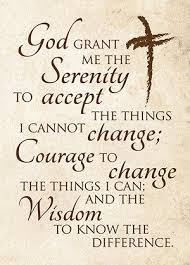Several years ago, as part of a group, I read the book, The Wisdom to Know the Difference. The title is from the last line of the Serenity Prayer used by Alcoholics Anonymous.
 A quote from the book’s introduction reads, “It simply means recognizing that while I can chart my own course in life, I don’t control the sea around my little boat. I can’t guarantee that I won’t ever get knocked into the waves, though I can learn to swim in case I do. I’ve found that recognizing both my power and my powerlessness is useful when facing life’s storms.”
A quote from the book’s introduction reads, “It simply means recognizing that while I can chart my own course in life, I don’t control the sea around my little boat. I can’t guarantee that I won’t ever get knocked into the waves, though I can learn to swim in case I do. I’ve found that recognizing both my power and my powerlessness is useful when facing life’s storms.”
Much of my needless suffering (if you aren’t sure what that means, ready my previous post) comes from being unable to distinguish between what is and is not in my control. When I imagine I have far more control than I actually do, I eventually get angry. My best efforts don’t yield the results I think I am entitled to. After all, I’m in charge, aren’t I?
Parenting was a constant wake-up call about control. I don’t remember how old my kids were when I realized I could not control them any longer, but it came much sooner than I expected. At that point I realized that if I was unwilling to use physical control, the only tools I had were persuasion and negotiation. Interestingly, I came to that realization before my kids did, so my persuasion substituted for control for a time.
Working as a therapist for college students was a constant reminder of my powerlessness to control and my need to negotiate with trust.
And then, of course, there’s being married.
Letting go of trying to control people and circumstances that really are outside my control is difficult and liberating. I can step away from some of my self-imposed suffering when I exercise the wisdom to know the difference.
0 Comments until now
Add your Comment!